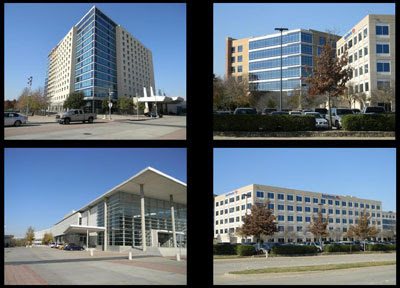 |
Source: City of Richardson. |
The diagram above is the new zoning for the property just to the east of the PGBT DART station platform. See that undifferentiated big block labeled "TOD Core"? In the old zoning, there was a network of streets there. Now a slide says, "The proposed development includes: Significant new corporate campus (1.5 million sf)."
In subsequent news, it appears that the tenant for that corporate campus will be State Farm Insurance. After the jump, why it's likely that State Farm being there won't make for a good neighbor.
Take that big block labeled "TOD Core," prime real estate just east of the DART station platform, and dedicate it to a corporate campus, and you no longer have transit-oriented development (TOD). Not unless that corporate campus is totally unlike the Blue Cross (1.05 million sf) or Cisco (1.0 million sf) campuses that the city's slide presentation uses for comparison. Put up something like what's in the photo below (also shown in the slide presentation) and Richardson will get another traditional office building buffered and isolated from the surrounding community. In short, a retreat from transit-oriented development.
 |
Source: City of Richardson. |
Instead of this, put up high-rises along the freeways, sure, but tie the ground floors to the surrounding street network with commercial storefronts (shops, restaurants, small businesses), and top the towers off with a half dozen or more floors of apartments and/or corporate offices. All this should be mixed, not segregated into separate blocks. Do that and you would have something worthy of the name, transit-oriented development.
The city is touting this as a big win, but I'm disappointed. I'm afraid that we're seeing the promise of mixed-use development morph into "corporate campus" along PGBT and apartments along Renner Rd. Richardson will have come up short at Spring Valley, at Arapaho, at Galatyn, and now at PGBT. Once the PGBT property is gone, there'll be nothing else in Richardson of its size and promise, anywhere, ever again, where we can get ever get it done right.

2 comments:
While having a long-term commitment from a corporation CAN be a win for the city, I can't help but wonder what, if any, tax abatement or other 'incentives' may have been offered to lure State Farm (or anyone else) here? Somehow, the shift from having a citizenry many of whom are well educated, highly paid engineers to a more traditional service-based economy does not necessarily sound like a good thing. (Though plainly Cisco is high-tech, I'm inclined not to think of Blue Cross or State Farm in that same vein.)
One thing I can aver in confidence, with the added traffic already generated by Blue Cross and the additional traffic State Farm will generate, Plano Road and the Galatin Park area will be bereft of much of the ambiance they have held previously.
The PGBT is a TIF zone, so there are incentives to develop the infrastructure. Beyond that, I don't what, if any, incentives are being used with individual companies. Overall, incentives do appear to be out of control, especially in Texas. See "Texas Picks Winners and Losers".
As for traffic congestion, paradoxically the way to address that is through higher-density, mixed-use development with access to public transit. That promotes walkability and reduces the need for car travel. [Comment comparing Dallas to London has been deleted. I didn't fact-check the numbers and I'm not sure what point the numbers make anyway.]
Post a Comment